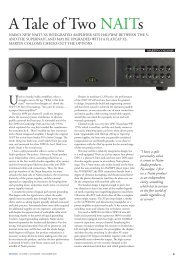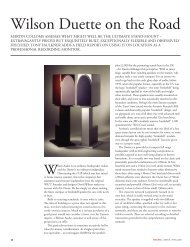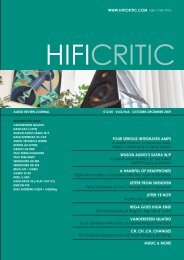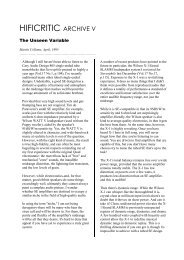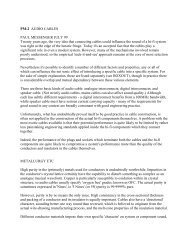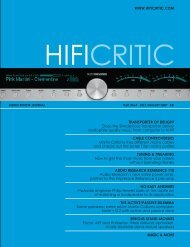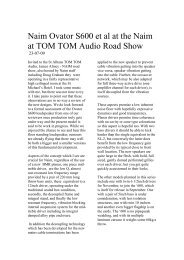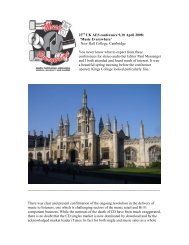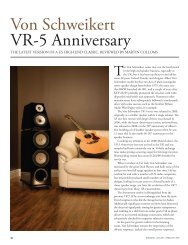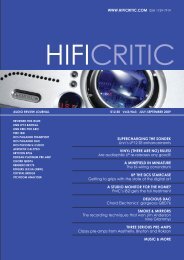Oh No, Not Another LS3/5a... - Hificritic.com
Oh No, Not Another LS3/5a... - Hificritic.com
Oh No, Not Another LS3/5a... - Hificritic.com
You also want an ePaper? Increase the reach of your titles
YUMPU automatically turns print PDFs into web optimized ePapers that Google loves.
<strong>Oh</strong> <strong>No</strong>, <strong>No</strong>t <strong>Another</strong> <strong>LS3</strong>/<strong>5a</strong>...<br />
THE BBC-LICENSED <strong>LS3</strong>/5A HELPED MAKE ROGERS INTO A GLOBAL BRAND. ITS CURRENT FAR<br />
EAST OWNERS HAVE WORKED WITH UK DESIGNERS AND MANUFACTURERS TO CREATE THIS<br />
BBC-LICENSED 11OHM ‘REVIVAL’<br />
We won’t labour the <strong>LS3</strong>/<strong>5a</strong> story, which<br />
began in the BBC in early 1970s, as<br />
this was covered in depth in Vol1 <strong>No</strong>3<br />
(May-June 2007). The fit and finish of this ‘official’<br />
£1499/pair Rogers revival was excellent. It certainly<br />
looks the part with its fine matched rosewood veneer,<br />
though the repro Tygan grille material might be<br />
a little softer and more open than the original. As<br />
expected, these speakers use a 5in (138mm) polymer<br />
cone bass/mid drive unit partnered by a nominally<br />
19mm dome tweeter, mounted in a sealed-box<br />
enclosure. Build detail includes thick felt absorption<br />
around the tweeter, to ameliorate reflection effects<br />
from the integral grille frame. (The <strong>LS3</strong>/<strong>5a</strong> is meant<br />
to be used with its grille in place.)<br />
This new example has a glued on back, as were<br />
most ‘3/<strong>5a</strong>s. The bass/mid driver has a 110mm<br />
pressed steel chassis with a flared, talc-filled<br />
polypropylene cone, powered by a double-wound<br />
voice-coil (the windings series connected), and a<br />
large ferrite magnet. A fine 19mm tweeter with<br />
recessed soft dome and sophisticated rear loading is<br />
fitted, while that unnecessary perforated metal cover<br />
<strong>com</strong>pletes the original look. Built of birch plywood<br />
according to the original recipe, the panels are well<br />
damped by traditional bitumen loaded pads, and the<br />
interior is lined with thick, absorbent polyurethane<br />
foam. This model is bi-wired (unlike the original)<br />
with average quality gold plate brass binding posts<br />
and brass link pins (preferably replaced by copper<br />
wire on installation). The crossover is built on the<br />
usual epoxy glass reinforced PCB, securely bolted<br />
to the panel area around the tweeter. It uses normal<br />
film capacitors, ferrite core inductors, and an array<br />
of resistors forming a calibrated attenuator to achieve<br />
the essential close tolerance matching of mid and<br />
treble levels. (The original 15ohm model used<br />
mu-metal cored transformer inductors and ratio<br />
matching of driver sensitivity levels.)<br />
Sound quality<br />
With references assembled, and memory not too<br />
dimmed from the pleasant experience of that other,<br />
Derek Hughes guided 11ohm ‘3/<strong>5a</strong> for Stirling<br />
Broadcast (Vol1 <strong>No</strong>3), I set to. Location as ever, was<br />
free space with little toe-in, and copper links fitted to<br />
the terminals.<br />
From the very start that genuine ‘3/<strong>5a</strong> magic was<br />
there, though inevitably at modest loudness levels.<br />
Shut your eyes and coloration is really low, and<br />
the soundstage is spacious, deep and focused. The<br />
natural timbre and the elegant, surprisingly deep<br />
image perspective reminds one of much larger and<br />
more costly designs. If a listener doesn’t demand<br />
higher volume levels or need cracking dynamics, it<br />
might not be necessary to go further than this in the<br />
quest for genuine high fidelity.<br />
In my opinion this is the best of the modern ‘3/<strong>5a</strong><br />
clones I’ve heard to date. It has quite good coloration<br />
in the low midrange – a weakness of many – though<br />
it is a little ‘boxier’ than the best 15ohm examples. It<br />
is also a little ‘sweet’, not quite as crisp and open as<br />
is possible, though one would not want it as bright<br />
as some later original Rogers 15ohm examples. This<br />
new contender is self-effacing, clean, even, smooth<br />
and well balanced, with a particularly seamless<br />
transition from midrange to treble, albeit a tad<br />
dynamically reticent in the piano’s middle register.<br />
Spacious, transparent and detailed, if a touch ‘darker’<br />
(and therefore not quite a dynamic, expressive,<br />
transparent or ‘powerful’), this new version of that<br />
old trouper just sounds bigger than the original, with<br />
a touch more realism.<br />
This new Rogers certainly has a good percentage<br />
of the better drive and timing of the earliest models.<br />
We should remember that middle period 15ohm<br />
models often sounded hard and ‘forward’ in the<br />
midband, only just meeting the BBC spec. This new<br />
version actually bests a huge number of the less good<br />
15ohm models, never mind the more boring 11ohm<br />
examples and most of the 3/5 ‘clones’ (which were<br />
never proper 3/<strong>5a</strong>s anyway). In reality this Rogers is<br />
MARTIN COLLOMS<br />
HIFICRITIC JULY | AUGUST | SEPTEMBER 2009 43
◆ REVIEW<br />
Amplification was via Orelle<br />
SA100 Evo and Naim<br />
SUPERNAIT, CD replay<br />
from Marantz CD-7, LP from<br />
Linn LP12, Superline/Hi-<br />
Cap, Koetsu RED T, Origin<br />
Live DC supply, cables from<br />
Kimber, vdH, DNM and Yter.<br />
AE Classic 24inch stands on<br />
BluTack ‘peas’.<br />
CONTACT<br />
RoyalHiFi<br />
Tel 01628 820134<br />
e-mail royalhifi@aol.<strong>com</strong><br />
Price: £1499/pair<br />
44<br />
quite close to the standard, <strong>com</strong>paring well with the<br />
equally well mannered and similarly neutral Stirling<br />
Broadcast version. I think that it may be just a little<br />
livelier musically than the Stirling Broadcast, but<br />
reckon you would have to do an A/B to find out.<br />
Measurement<br />
The spec says 83dB/W sensitivity, some 1.5dB<br />
higher than the original 15ohm model, and truthful.<br />
Frequency responses were very tidy, and with superb<br />
pair matching. The on-axis frequency response gives<br />
70Hz to 29kHz +/-3dB, with -6dB points at 60Hz<br />
and 30kHz. Partnering stands should not be too<br />
high because the response dips sharply by 10dB at 10<br />
degrees below the axis in the crossover zone, around<br />
3.3kHz, while remaining perfect at 10 degrees above.<br />
The speaker should therefore be sited at or a little<br />
below seated ear level. The off-axis lateral results were<br />
good too, but that noted dip was beginning to show<br />
itself in the 45 and 60 degree off-axis results. The<br />
small tweeter keeps the output going nicely up to<br />
11kHz off-axis, so it should stay open and clear. The<br />
Rogers Royal <strong>LS3</strong>/<strong>5a</strong> Frequency Responses<br />
Rogers Royal <strong>LS3</strong>/<strong>5a</strong> impedance (black) and phase<br />
(blue dashed)<br />
bass is understandably limited with some characteristic<br />
‘plumpness’ 80-150Hz, though this is part of the<br />
‘voice’ of this little box. The in-room averaged<br />
response (not shown) is very good: it’s typical for the<br />
size, with good overall power integration and with inroom<br />
bass down to about 50Hz.<br />
The impedance graph shows an average value of<br />
about 7ohms. It’s easy to drive, with a minimum<br />
of 5ohms and moderate variation. The box bass<br />
resonance is seen at 91Hz. The waterfall response is<br />
quite tidy, well integrated in the early response, with<br />
only moderate decay ‘clutter’ thereafter. Enclosure<br />
coloration is low thanks to the good construction<br />
and small acoustic footprint.<br />
Conclusions<br />
This <strong>LS3</strong>/<strong>5a</strong> contender can be re<strong>com</strong>mended. It’s<br />
beautifully made with great care and fine finish, and<br />
while I still await the equal of my ancient Robin<br />
Marshall made BBC originals perhaps it simply<br />
cannot be done, as some of the materials used to<br />
make that speaker are no longer available.<br />
Rogers Royal <strong>LS3</strong>/<strong>5a</strong> Waterfall decay response<br />
SPECIFICATIONS<br />
Type ______________________________________________<br />
two-way sealed-box<br />
Drivers ______________________________________________<br />
Bass/mid 110mm pressed steel frame, 85mm<br />
______________________________________________<br />
filled polymer cone, twin voice coil<br />
Treble 19mm soft dome, acoustically<br />
______________________________________________<br />
loaded front and back<br />
Crossover ______________________________________________<br />
3kHz<br />
Enclosure 10mm birch multi-ply, real wood<br />
(wxhxd) veneer<br />
Dimensions ______________________________________________<br />
18.8 x 30.2 x 16.8cm<br />
Frequency ______________________________________________<br />
response 70Hz to 20kHz (+,- 3dB)<br />
Impedance ______________________________________________<br />
11 ohms, bi-wire terminals<br />
Sensitivity ______________________________________________<br />
83dB/W<br />
Power ______________________________________________<br />
30-80W<br />
______________________________________________<br />
Price per pair £1500<br />
Contact royalhifi@aol.<strong>com</strong><br />
HIFICRITIC JULY | AUGUST | SEPTEMBER 2009




